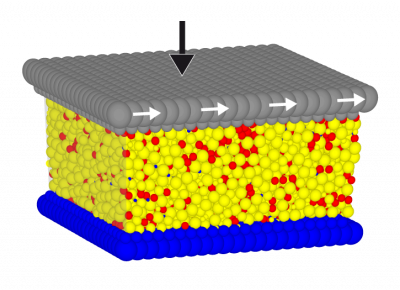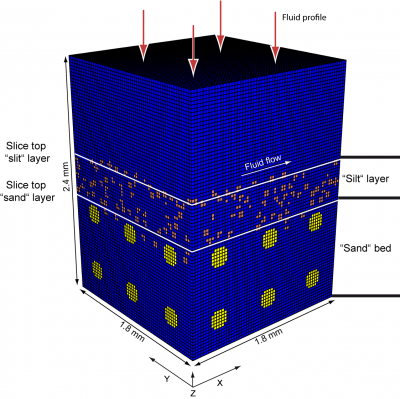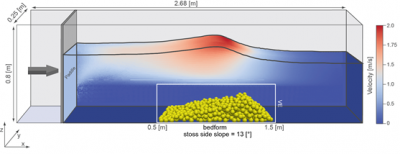Page path:
- Modelling of Sedimentation Processes
- Numerical Modelling
Numerical Modelling

DEM - Discrete Element Method
The Discrete Element Method (DEM) is a granular based numerical simulation technique. A 'synthetic' material package is built up of discrete spherical particles, e.g. spheres, discs of ellipsoids. They interact at common contact points due to given boundary conditions according to simple physical laws. Using Newton's second law can be used to calculated displacements and new particle positions.

Continuums methods
Continuum approaches (e.g., the finite-difference and finite-element method) are used to gain numerical approximations for complex geological processes. Typically, the deformation of a given structure under applied stress conditions is simulated. Thereby, the basic assumption of the continuum approach is the presence of a coherent model domain all over the model run.

Smoothed Particle Hydrodynamics
Smooth Particle Hydrodynamics (SPH) has been widely used to study free surface flows. Due to the Lagragian environment, SPH does not need a mesh or grid to discretize the physical domain (study area). In any SPH model the physical domain is discretized by a finite number of numerical particles that interact with each other following the fluid conservation laws (Monagham, 1992). Thereby, each particle in a SPH model is assigned with its own physical properties such as mass, density or pressure. In the case of a fluid, the physical integration between individual fluid particles is solved following mesh less, lagrangian model aiming at solving the Navier-Stokes equations through the convolution-based discretization (Dalrymple and Rodgers, 2007). Using SPH allows simulating various flow features in a water body such as turbulences in three dimensions.

Current Projects
Gerhard Bartzke
Sediment dynamics - Fluid and sediment bed interactions. What roles do fluid infiltration and grain shape play? - 3D numerical flume tank experiments
This project was inspired by the inherent limitations in the quantification of the physical parameters (e.g., flow speed and grain shape) controlling sediment-fluid interactions in the direct vicinity of the sediment water interface and in the interior of a sediment bed. For investigation of the processes influencing the erosion characteristics of sediments beds, researchers commonly tested the transport behaviour sediment beds empirically using laboratory flume tanks or in situ field investigations. However, a precise quantification of the processes occurring in the direct vicinity and in the interior of the sediment body, such as the fluid infiltration rates into the sediment bed, is difficult when using these techniques. Therefore, the physical processes in the interior of a sediment bed require further investigation. With a focus on the physical processes, occurring in the direct vicinity and in the interior of a sediment bed, the overall goal of this proposed research is to identify and quantify the role of fluid infiltration and grain shape variations on the transport behaviour of sediments beds using 3D numerical simulations. By the use of the numerical Smooth Particle Hydrodynamics (SPH) method, uniform sediment beds composed of different grain shapes, will be tested in a 3D numerical flume tank under different current velocities. Physical features, such as the role of fluid inflow and grain shape variations on the transport characteristics will be measured at high resolution in the direct vicinity and in the interior of the sediment beds.
This project was inspired by the inherent limitations in the quantification of the physical parameters (e.g., flow speed and grain shape) controlling sediment-fluid interactions in the direct vicinity of the sediment water interface and in the interior of a sediment bed. For investigation of the processes influencing the erosion characteristics of sediments beds, researchers commonly tested the transport behaviour sediment beds empirically using laboratory flume tanks or in situ field investigations. However, a precise quantification of the processes occurring in the direct vicinity and in the interior of the sediment body, such as the fluid infiltration rates into the sediment bed, is difficult when using these techniques. Therefore, the physical processes in the interior of a sediment bed require further investigation. With a focus on the physical processes, occurring in the direct vicinity and in the interior of a sediment bed, the overall goal of this proposed research is to identify and quantify the role of fluid infiltration and grain shape variations on the transport behaviour of sediments beds using 3D numerical simulations. By the use of the numerical Smooth Particle Hydrodynamics (SPH) method, uniform sediment beds composed of different grain shapes, will be tested in a 3D numerical flume tank under different current velocities. Physical features, such as the role of fluid inflow and grain shape variations on the transport characteristics will be measured at high resolution in the direct vicinity and in the interior of the sediment beds.

Former Projects
Franziska Staudt
Initiation of motion: investigating sediment remobilization processes combining lab flume tank experiments, field measurement and numerical simulations
Describing sediment erosion is an important factor for the understanding of coastal processes. Erosion, i.e. the movement of single sediment grains, is initiated when the hydrodynamic driving force outweighs the grain resistance force. In addition to the flow field and the grain size and weight, other key parameters play a role in the initiation of motion: cohesive forces in between particles, stabilization or destabilization through biological activity, or so-called caging structures, i.e. textural induced structures of fine particles (clay) encompassing coarser sand grains (Le Hir et al. 2008, Mitchener and Torfs, 1996).
Describing sediment erosion is an important factor for the understanding of coastal processes. Erosion, i.e. the movement of single sediment grains, is initiated when the hydrodynamic driving force outweighs the grain resistance force. In addition to the flow field and the grain size and weight, other key parameters play a role in the initiation of motion: cohesive forces in between particles, stabilization or destabilization through biological activity, or so-called caging structures, i.e. textural induced structures of fine particles (clay) encompassing coarser sand grains (Le Hir et al. 2008, Mitchener and Torfs, 1996).
| More details about the project on INTERCOAST |

Gerhard Bartzke
Micro scale sediment - fluid interactions
Sediment erosion is understood as the initiation of motion of single grains by a hydrodynamic driving force. Most classical studies have attempted to predict sediment erosion as a function of single grain size at a defined flow force, e.g., Shields (1936) and Hjulstroem (1935). However, at present, it is understood that the erosion behavior of sediments is also controlled by additional factors that shift the initial erosion conditions towards higher regimes.
Sediment erosion is understood as the initiation of motion of single grains by a hydrodynamic driving force. Most classical studies have attempted to predict sediment erosion as a function of single grain size at a defined flow force, e.g., Shields (1936) and Hjulstroem (1935). However, at present, it is understood that the erosion behavior of sediments is also controlled by additional factors that shift the initial erosion conditions towards higher regimes.
| More details about the project on INTERCOAST |
| More details about the project on INTERCOAST |

Linda Wenk
Numerical simulation of mechanics and kinematics of the Mediterranean Ridge - key role of viscous décollements
The eastern Mediterranean Sea is a complex tectonic area observable from high seismicity and active volcanism. The major tectonic feature in the Eastern Mediterranean is the Hellenic subduction zone where the Nubian Plate dips beneath the Aegean Plate. This process is associated to fault zone activity and numerous earthquakes.
As a consequence of the north-facing subduction a large sedimentary wedge evolved – the Mediterranean Ridge. Here, oceanic sediments deposited since the Mesozoic on the subducting African plate are off-scrapped and accreted to the overriding Eurasian Plate since Miocene .
In accordance to the Critical Taper Theory by DAHLEN et al. (1983), several studies have shown that the physical properties of the basal detachment of such accretionary wedges – the décollement - control their kinematics and mechanics. This also includes their dewatering behaviour and the fluid flow pathways.
Hence, the Mediterranean ridge represents an excellent case study area to investigate the key role of the strength of basal detachment as here the décollement material strongly varies along the subduction zone.
The eastern as well as western part of the Mediterranean wedge is underlying by large evaporite horizons. At some places these accumulated salt reaches a thickness of more than 1.8 - 2 km. These Messinian evaporites act as a weak décollement because of their physical properties. This results in the development of a frontal accreted, thinner wedge with a narrower taper. The taper is the smallest of any accretionary prism documented. Hence, these evaporite deposits have a wide influence on the tectonic behaviour of the wedge.
In addition, the different accretionary modes and therewith fault geometries and activities produce different dewatering behaviour, fluid migration and drainage pathways along the frontal part of the Hellenic subduction zone Hence, numerous fluid venting locations could be recognized by more than hundred mud volcanoes in the Mediterranean Ridge.
The eastern Mediterranean Sea is a complex tectonic area observable from high seismicity and active volcanism. The major tectonic feature in the Eastern Mediterranean is the Hellenic subduction zone where the Nubian Plate dips beneath the Aegean Plate. This process is associated to fault zone activity and numerous earthquakes.
As a consequence of the north-facing subduction a large sedimentary wedge evolved – the Mediterranean Ridge. Here, oceanic sediments deposited since the Mesozoic on the subducting African plate are off-scrapped and accreted to the overriding Eurasian Plate since Miocene .
In accordance to the Critical Taper Theory by DAHLEN et al. (1983), several studies have shown that the physical properties of the basal detachment of such accretionary wedges – the décollement - control their kinematics and mechanics. This also includes their dewatering behaviour and the fluid flow pathways.
Hence, the Mediterranean ridge represents an excellent case study area to investigate the key role of the strength of basal detachment as here the décollement material strongly varies along the subduction zone.
The eastern as well as western part of the Mediterranean wedge is underlying by large evaporite horizons. At some places these accumulated salt reaches a thickness of more than 1.8 - 2 km. These Messinian evaporites act as a weak décollement because of their physical properties. This results in the development of a frontal accreted, thinner wedge with a narrower taper. The taper is the smallest of any accretionary prism documented. Hence, these evaporite deposits have a wide influence on the tectonic behaviour of the wedge.
In addition, the different accretionary modes and therewith fault geometries and activities produce different dewatering behaviour, fluid migration and drainage pathways along the frontal part of the Hellenic subduction zone Hence, numerous fluid venting locations could be recognized by more than hundred mud volcanoes in the Mediterranean Ridge.

Lutz Torbahn
Physical characterisation of marine slope sediments utilizing numerical 3-D experiments
Nowadays the behaviour of submarine continental slopes is unsatisfactory investigate. Important questions which are necessary to answer deals with zones of stability inside slopes. Why do zones of weakness exist and where and when do they occur? What influence the shear plane of the submarine land slide significantly? What other factors play an important role?
To answer these questions we use a numerical method which is called Discrete Element Method (DEM). The DEM is established for such scientific problems. With the help of this numerical method we can determine and analyse material properties of sediment units in microscale.
Nowadays the behaviour of submarine continental slopes is unsatisfactory investigate. Important questions which are necessary to answer deals with zones of stability inside slopes. Why do zones of weakness exist and where and when do they occur? What influence the shear plane of the submarine land slide significantly? What other factors play an important role?
To answer these questions we use a numerical method which is called Discrete Element Method (DEM). The DEM is established for such scientific problems. With the help of this numerical method we can determine and analyse material properties of sediment units in microscale.






